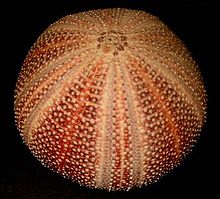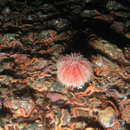Biology
provided by Arkive
The common sea urchin browses on seaweeds and invertebrates (2), moving along the sea floor by means of 'tube feet', which project out from the spines (4). The mouth is located centrally on the underside of the test, and is furnished with a group of 5 specialised calcareous plates, known as an 'Aristotle's lantern' which acts as a jaw (4).
The sexes are separate, breeding takes place in spring, and fertilisation is external (3). A microscopic four-armed larval stage forms; this 'echinopluteus' larva is free-swimming and makes up an important part of the plankton for around 8 weeks, before undergoing a complex metamorphosis into a small urchin (3). Maturity is reached at between 1 and 3 years of age, and estimates of maximum lifespan vary from 10 to 16 years of age (3).
Conservation
provided by Arkive
This species occurs in a number of candidate Special Areas of Conservation (7).
Description
provided by Arkive
The edible or common sea urchin has a large, rounded 'shell', which is actually an external skeleton, correctly called a 'test', composed of calcareous plates. It is usually pinkish-red in colour but more rarely may be shades of yellow, green or purple (2). The shape of the test varies depending on the depth of the water; those of individuals living in shallow water tend to be more flat than those of individuals living in deep water (3). The Latin name for the genus 'Echinus' derives from the Greek for 'spiny'; the test bristles with many protective reddish spines with lilac coloured tips (2).
Habitat
provided by Arkive
Occasionally may be found on the lower shore, but highest densities occur offshore (3), where it lives on rocky surfaces (2). It usually reaches depths of around 40 m, but has been found at over 100 m deep (2).
Range
provided by Arkive
Although widespread and common in much of Britain, this species is absent from some areas of north Wales, the east coast of England and the eastern part of the English Channel (2). It has a broad range in northwest Europe (3), from Finland and Iceland in the north, reaching south to Portugal (2).
Status
provided by Arkive
Widespread in Britain. Classified as Lower Risk/ near threatened (LR/nt) on the IUCN Red List 2002 (2).
Threats
provided by Arkive
The common and scientific names suggest that this sea urchin is edible (esculentus is the Latin word for 'edible'), yet only the reproductive organs (roe) can be eaten (5). There is a large international market for sea urchin products, particularly the roe (6). Exploitation of sea urchins grew rapidly in many countries, and in many cases over-exploitation and collapse of the sea urchin populations followed (6). There was a sea urchin fishery in Cornwall in the 1980s, and the potential of a fishery in Shetland has been investigated (2). The edible sea urchin has also been collected commercially for the curio trade (2).
Associations
provided by BioImages, the virtual fieldguide, UK
Animal / parasite / ectoparasite
adult of Pelseneeria stylifera ectoparasitises Echinus esculentus
Echinus esculentus
provided by wikipedia EN
Echinus esculentus, the European edible sea urchin or common sea urchin, is a species of marine invertebrate in the Echinidae family. It is found in coastal areas of western Europe down to a depth of 1,200 m (3,900 ft).[3] It is considered "Near threatened" in the IUCN Red List of Threatened Species.[1]

Test of
Echinus esculentus
Description
E. esculentus is approximately spherical but slightly flattened at both poles. It is reddish or purplish with white tubercles and grows to about ten centimetres in diameter. The brittle, limy test is rigid and divided into five ambulacral areas separated by five inter-ambulacral areas. There are two rows of plates in each of these areas, making twenty rows of plates in total. The test is covered in spines each articulating with a tubercle. There is a dense covering of secondary spines and a smaller number of longer, primary spines, carried on each second or third ambulacral plate. The spines are blunt ended and usually white with purplish tips. There is a radially symmetrical pattern of holes in the ambulacral areas through which the tube feet emerge. On the buccal plates round the mouth on the underside are pedicellariae, defensive organs like minute pincers, each with two lateral teeth and one terminal tooth.[3][4] It typically reaches a diameter of 15–16 cm (5.9–6.3 in), but has been recorded to 17.6 cm (6.9 in).[5]
Distribution
In the North Sea, the species is common in all areas with hard substrates. It is found off the coasts of Portugal, Spain, France, Belgium, the Netherlands, Denmark, Norway, Iceland, Sweden, the United Kingdom and Ireland.[3]
Biology

A male sea urchin,
Echinus esculentus releasing sperm, Strangford Lough, Northern Ireland.
The mouthparts are designed for rasping and E. esculentus feeds on algae and encrusting invertebrates.[6] It has been recorded feeding on worms, barnacles, hydroids, tunicates, bryozoans, algae such as Laminaria spp., sludge and detritus.[7]
Spawning mainly occurs in the spring and a large female may release about 20 million eggs into the water column. The larvae become part of the plankton, the development of which is complex and takes between forty-five to sixty days in captivity.[8] It includes a blastula, gastrula and a four armed echinopluteus stage that forms an important part of the zooplankton.[9] Settlement mostly occurs in autumn and winter and the largest number of juvenile urchins was found at a greater depth than the kelp zone.[10]
The polychaete worm, Adyte assimilis and the copepod Pseudoanthessius liber are often found living as commensals among its spines and the parasitic copepod, Asterocheres echinola, often infests its gut.[11]
Use as food
The species name esculentus means "edible". Sea urchin roe is used as food around the world, but esculentus is not among the preferred sea urchin species, due to its white gonads. Sea urchin species with orange gonads are preferred. It is not actually the eggs that are eaten but the gonads, both male and female.[12] Fishing for urchins is undertaken off European coasts and the possibility of aquaculture is being investigated. In a study off the west coast of Scotland it was found that feeding a commercially available salmon feed promoted gonadal growth in the urchins and the practicalities of a fully farmed approach were being assessed.[13]
References
-
^ a b World Conservation Monitoring Centre (1996). "Echinus esculentus". IUCN Red List of Threatened Species. 1996: e.T7011A12821364. doi:10.2305/IUCN.UK.1996.RLTS.T7011A12821364.en. Retrieved 14 November 2021.
-
^ Andreas Kroh & Hans Hansson (2011). A. Kroh & R. Mooi (eds.). "Echinus esculentus". World Echinoidea Database. World Register of Marine Species. Retrieved June 25, 2011.
-
^ a b c Marine Species Identification Portal
-
^ John Barrett and C M Young, Collins Pocket Guide to the Sea Shore (1958) p.181
-
^ MarLIN: Edible sea urchin - Echinus esculentus. Retrieved 11 September 2014.
-
^ Encyclopedia of Marine Life of Britain and Ireland
-
^ Lawrence, J.M., 1975. On the relationship between plants and sea-urchins. Oceanography and Marine Biology: an Annual Review, 13, 213-286.
-
^ MacBride, E.W., 1914. Textbook of Embryology, Vol. I, Invertebrata. London: MacMillan & Co.
-
^ MacBride, E.W., 1903. The development of Echinus esculentus together with some points on the development of E. miliaris and E. acutus. Philosophical Transactions of the Royal Society of London, Series B, 195, 285-327.
-
^ Comely, C.A. & Ansell, A.D., 1988. Invertebrate associates of the sea urchin Echinus esculentus L. from the Scottish west coast. Ophelia, 28, 111-137.
-
^ MarLIN
-
^ John M. Lawrence (2001). "The edible sea-urchins". In Lawrence (ed.). Edible Sea Urchins: Biology and Ecology. Developments in Aquaculture and Fisheries Science. Vol. 32. pp. 1–4. doi:10.1016/S0167-9309(01)80002-8. ISBN 9780444503909.
-
^ M. S. Kelly; P. V. Owen & P. Pantazis (2001). G. Burnell (ed.). "The commercial potential of the common sea urchin Echinus esculentus from the west coast of Scotland". Hydrobiologia. 465 (1–3): 85–94. doi:10.1023/A:1014553010711. S2CID 30962276.

- license
- cc-by-sa-3.0
- copyright
- Wikipedia authors and editors
Echinus esculentus: Brief Summary
provided by wikipedia EN
Echinus esculentus, the European edible sea urchin or common sea urchin, is a species of marine invertebrate in the Echinidae family. It is found in coastal areas of western Europe down to a depth of 1,200 m (3,900 ft). It is considered "Near threatened" in the IUCN Red List of Threatened Species.

Test of Echinus esculentus
- license
- cc-by-sa-3.0
- copyright
- Wikipedia authors and editors
Breeding
provided by World Register of Marine Species
Echinopluteus larva. Early sumer
Distribution
provided by World Register of Marine Species
Not Mediterranean
Hayward, P.J. & J.S. Ryland (Eds.). (1990). The marine fauna of the British Isles and North-West Europe: 1. Introduction and protozoans to arthropods. Clarendon Press: Oxford, UK. 627 pp.
- license
- cc-by-4.0
- copyright
- WoRMS Editorial Board
Distribution
provided by World Register of Marine Species
From low intertidal, but mainly in the sublittoral zone, down to 40 m depth, occasionally deeper, on rocks, stones or seaweed; the common sea urchin all round the British Isles
IUCN Red List Category
provided by World Register of Marine Species
IUCN Red List 1996 Low Risk/Near Threatened (Vers. 2.3)
- license
- cc-by-4.0
- copyright
- WoRMS Editorial Board


 Test of Echinus esculentus
Test of Echinus esculentus